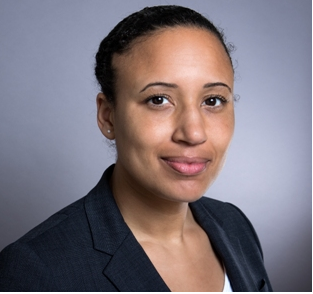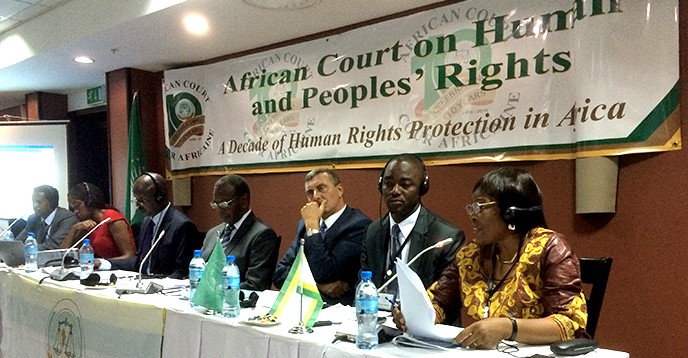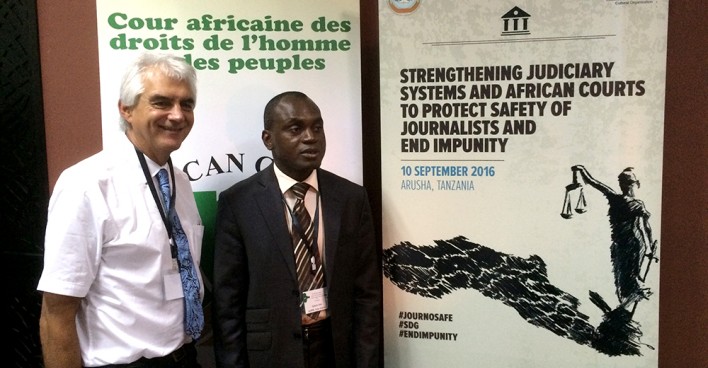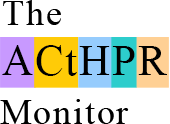Many readers will know that the African Court and UNESCO recently organized a seminar on the strengthening of judiciary systems and African Courts ability to protect the safety of journalists. I am delighted to welcome Nani Jansen Reventlow who attended the seminar back to The Monitor with this guest post on this important event. (For those who may have missed it, you can also read Nani’s recent Q&A on The ACtHPR Monitor here)

On 10 September, the African Court and UNESCO convened a seminar on “Strengthening judiciary systems and African Courts to protect the safety of journalists and end impunity” in Arusha, Tanzania. Attended by some 100 participants, the seminar was the first of a series of events leading up to the commemoration of the International Day to End Impunity for Crimes Against Journalists, which takes place on 2 November. As was highlighted by the former President of the Court, Mr Ramadhani, the event also took place in the context of the 10-year anniversary of the African Court and the African year of human rights.
The seminar consisted of three main panels, focusing on African jurisprudence and international standards, the capacity of judicial actors at the national level, and the Protocol and declaration of the Court.
The first panel, on African jurisprudence and international standards, had a very optimistic tone. Panelists provided an overview of the various treaty provisions, declarations, and resolutions protecting free speech across the continent, including the sub regional human rights systems, after which the focus fell on the relevant jurisprudence. The African Court’s decisions in the Zongo and Konaté cases were consistently referred to as having set a positive standard for the protection of journalists. Other cases that helped shape the legal framework for the protection of journalists that were discussed included the Hydara, Chief Manneh, and Saidykhan cases, decided by the ECOWAS Community Court of Justice.
When discussing the issue of enforcement, there was consensus amongst the panelists that this was mainly a political process; as was expressed by the African Court and ECOWAS judges on the panel, the matter was out of their hands once judgment had been handed down. The follow-up by Burkina Faso on Zongo had been positive, and the criminal defamation laws had been amended following Konaté (implementation of the reparations judgment is still pending), but enforcement of the ECOWAS Court’s judgments in the cases against The Gambia had been fully absent. Sanctions for non-implementation, even where available, were often not used due to a lack of political will. The role of civil society in the implementation was crucial: national human rights institutions and NGOs had to actively pursue implementation at both the national level and international level, including at fora such as the UN Human Rights Council’s UPR process and State reporting to the African Commission. Further strategies that were mentioned were “naming and shaming” and the need to create better access to the jurisprudence created by the courts on the continent.

The main question addressed in the second panel, which looked at the capacity of judicial actors at the national level, was how to reinforce capacity within the national judicial systems regarding freedom of expression issues. Challenges flagged focused on the lack of both knowledge and proper use of freedom of expression standards. As one of the panelists commented: “if lawyers don’t make the right freedom of expression arguments, the judges’ hands are tied”. Another problem identified was that there were only very few people who were well-versed in freedom of expression rights. This created a high-risk situation: if the few lawyers defending all the free speech cases became unavailable, there was no one to pick up the work. Training was a possible solution for this, but it was agreed that this should focus on a wide range of actors, including prosecutors and law enforcement, and that one-off trainings would not suffice.
An important point was made in that criminal defamation was not the only problem journalists faced. Sedition, false news, insult and anti-terrorism laws equally posed a threat to free speech. Moreover, civil defamation could pose a significant risk due to the high damages awarded, often without grounds, that could bankrupt an individual or a news outlet.
In the third session, panelists looked at strategies to increase the ratification of the Protocol and the number of declarations made under Article 34(6) of the African Court Protocol. After all, the African Court’s ability to protect journalists is dependent on whether or not it has jurisdiction. With 30 ratifications and 7 declarations, there was still some way to go towards universal ratification. Some of the reasons mentioned for non-universal ratification of the protocol were lack of political will, confusion on the various protocols establishing the various courts, especially the African Court of Justice and Human Rights, and a degree of negligence on the part of AU Member States. The panelists discussed the various efforts undertaken by the Court, the Commission and others to increase the number of ratifications, which had had some results, but not to the extent that universal ratification had been achieved. Some of the reasons identified for this failure was a lack of resources to undertake proper follow-up, for example for the African Court to follow up after a sensitisation visit. It was suggested that possible new strategies to increase the number of ratifications and declarations should focus on involving actors other than only States and the AU: NGOs, civil society and also other inter-governmental organisations, such as the UN and its treaty bodies.

Rwanda’s withdrawal of its Article 34(6) declaration was also discussed, a subject which has been discussed here, here and here. It was acknowledged that this certainly was not a positive development, but that it was difficult to assess the impact at this stage. Most notably, one of the panelists mentioned that Rwanda had indicated that it might re-deposit the declaration at a later stage.
The overall conclusion of the discussions of the day was that currently a decent tool-set to defend journalists is in place: a legal framework comprising both hard norms, such as the various treaties, and soft ones, such as the UNESCO framework, solid jurisprudence from the Court, and the eagerness of the different actors to make it work. Given the current state of play for press freedom in Africa, what now needs to be done is to figure out how these tools can be used better.
